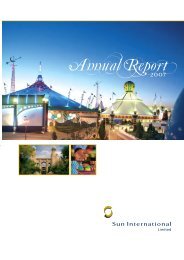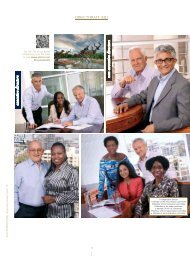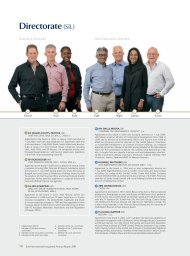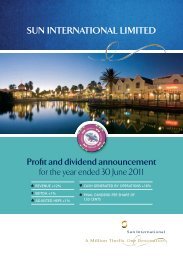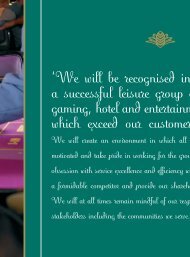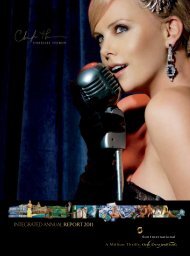PDF 25 MB - Sun International | Investor Centre
PDF 25 MB - Sun International | Investor Centre
PDF 25 MB - Sun International | Investor Centre
Create successful ePaper yourself
Turn your PDF publications into a flip-book with our unique Google optimized e-Paper software.
which the entity operates (the functional currency). The consolidated<br />
financial statements are presented in South African Rands which is the<br />
group’s functional and presentation currency.<br />
Transactions and balances<br />
Transactions denominated in foreign currencies are translated at the rate<br />
of exchange ruling on the transaction date. Monetary items denominated<br />
in foreign currencies are translated at the rate of exchange ruling at the<br />
end of the reporting period. Gains or losses arising on translation are<br />
credited to or charged against income.<br />
Foreign entities<br />
The financial statements of foreign entities that have a functional currency<br />
different from the presentation currency are translated into South African<br />
Rands as follows:<br />
� Assets and liabilities, at exchange rates ruling at the last day of the<br />
reporting period.<br />
� Income, expenditure and cash flow items at average exchange rates.<br />
� Premiums on transactions with minorities and fair value adjustments<br />
arising from the acquisition of a foreign entity are reported using the<br />
exchange rate at the date of the transaction.<br />
All resulting exchange differences are reflected as part of shareholders’<br />
equity. On disposal, such translation differences are recognised in the<br />
statement of comprehensive income as part of the cumulative gain or loss<br />
on disposal.<br />
PROPERTY, PLANT AND EQUIPMENT<br />
Freehold land is included at cost and not depreciated.<br />
All other items of property, plant and equipment are stated at historical<br />
cost and depreciated over periods deemed appropriate to reduce carrying<br />
values to estimated residual values over their useful lives. Historical cost<br />
includes expenditure that is directly attributable to the acquisition of these<br />
items. Depreciation is calculated on the straight-line method. The<br />
principal useful lives over which the assets are depreciated are as follows:<br />
Freehold and leasehold buildings <strong>25</strong> to 50 years<br />
Infrastructure 10 to 50 years<br />
Plant and machinery 10 to <strong>25</strong> years<br />
Equipment 4 to 14 years<br />
Furniture and fittings 5 to 10 years<br />
Vehicles 4 to 10 years<br />
The assets’ residual values and useful lives are reviewed annually, and<br />
adjusted if appropriate, at each financial reporting date.<br />
Operating equipment (which includes uniforms, casino chips, kitchen<br />
utensils, crockery, cutlery and linen) is recognised as an expense based<br />
on usage. The period of usage depends on the nature of the operating<br />
equipment and varies between one to three years.<br />
ACCOUNTING POLICIES continued<br />
Gains and losses on disposals are determined by comparing the proceeds<br />
with the carrying amount and are recognised in the statement of<br />
comprehensive income.<br />
When the carrying amount of an asset is greater than its estimated<br />
recoverable amount, it is written down immediately to its recoverable<br />
amount.<br />
Costs arising subsequent to the acquisition of an asset are included in the<br />
asset’s carrying amount or recognised as a separate asset, as appropriate,<br />
only when it is probable that future economic benefits associated with the<br />
item will flow to the group and the cost of the item can be measured<br />
reliably. All other repairs and maintenance costs are charged to the<br />
statement of comprehensive income during the financial year in which<br />
they are incurred.<br />
Costs associated with developing or maintaining computer software<br />
programmes are recognised as an expense as incurred. However, costs<br />
that are directly associated with identifiable and unique software products<br />
controlled by the group and which have probable economic benefits<br />
exceeding the costs beyond one year are recognised as intangible assets.<br />
Direct costs include staff costs of the software development team and an<br />
appropriate portion of the relevant overheads. Expenditure meeting the<br />
definition of an asset is recognised as a capital improvement and added<br />
to the original cost of the asset.<br />
Borrowing costs and certain direct costs relating to major capital projects<br />
are capitalised during the period of development or construction.<br />
IMPAIRMENT OF ASSETS<br />
Assets that have an indefinite useful life are not subject to amortisation<br />
and are tested annually for impairment. Assets that are subject to<br />
amortisation are reviewed for impairment whenever events or changes in<br />
circumstances indicate that the carrying amount may not be recoverable.<br />
An impairment loss is recognised for the amount by which the asset’s<br />
carrying amount exceeds its recoverable amount. The recoverable amount<br />
is the higher of an asset’s fair value less costs to sell and value in use.<br />
For the purpose of assessing impairment, assets are grouped at the lowest<br />
levels for which there are separately identifiable cash flows (cash<br />
generating units).<br />
PRE-OPENING EXPENDITURE<br />
Pre-opening expenditure is charged directly against income and separately<br />
disclosed. These costs include all marketing, operating and training expenses<br />
incurred prior to the opening of a new hotel or casino development.<br />
INVENTORY<br />
Inventory is valued at the lower of cost and net realisable value on a firstin,<br />
first-out basis. Net realisable value is the estimated selling price in the<br />
ordinary course of business.<br />
145



